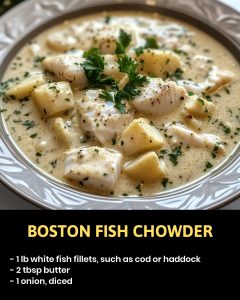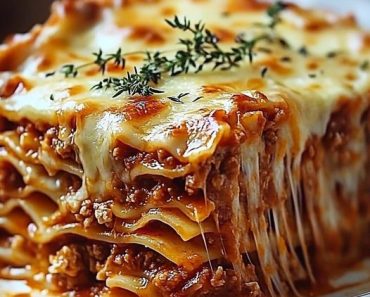
Boston Fish Chowder: A Cozy Taste of New England
Boston Fish Chowder is the epitome of coastal comfort food. This creamy, hearty dish captures the essence of New England’s seaside charm with tender chunks of flaky white fish, creamy potatoes, and aromatic vegetables. Perfect for brisk evenings or when you’re craving a bowl of rich, soul-warming goodness, this recipe is simple to prepare and packed with flavor.
Ingredients Overview: Understanding the Essentials
- White Fish Fillets (1 lb):
Cod or haddock work best for their mild flavor and firm texture. They flake beautifully into the creamy chowder. - Butter (2 tbsp):
Adds a velvety richness and helps sauté the aromatics to perfection. - Onion (1, diced):
Sweet and savory, it forms the flavor base of the chowder. - Celery (2 stalks, diced):
Brings a subtle earthy crunch and complements the onion. - Potatoes (3, peeled and cubed):
A hearty addition that absorbs the savory flavors of the chowder. - Fish or Vegetable Stock (2 cups):
Enhances the natural seafood flavor—choose fish stock for an authentic taste. - Milk (1 cup):
Provides creaminess and lightens the heavy cream for a balanced texture. - Heavy Cream (1 cup):
Adds luxurious richness to the chowder. - Salt & Pepper:
Simple seasonings that bring the dish together. - Fresh Parsley (for garnish):
Brightens the dish with a pop of color and fresh flavor.
Step-by-Step Cooking Instructions
Step 1: Sauté the Aromatics
In a large pot, melt 2 tablespoons of butter over medium heat. Add the diced onion and celery, stirring occasionally until they soften and turn translucent (about 5 minutes).
Step 2: Build the Base
Add the cubed potatoes and 2 cups of stock to the pot. Increase the heat to bring the mixture to a boil, then reduce it to a simmer. Cover and cook until the potatoes are tender, about 12-15 minutes.
Step 3: Add the Fish
Gently place the white fish fillets into the pot. Simmer for 5-7 minutes, or until the fish becomes opaque and easily flakes with a fork.
Step 4: Incorporate the Creamy Elements
Stir in the 1 cup of milk and 1 cup of heavy cream, allowing the chowder to warm through without boiling. Season generously with salt and pepper to taste.
Step 5: Garnish and Serve
Ladle the chowder into bowls and garnish with chopped fresh parsley. Serve hot, paired with crusty bread or oyster crackers for the ultimate experience.
Valuable Tips for Perfect Fish Chowder
- Fresh Fish is Key: Always use the freshest fish available for the best flavor. Frozen fillets work in a pinch—just thaw them completely before cooking.
- Low and Slow for Cream: Never let the chowder boil after adding milk or cream to prevent curdling.
- Enhance the Broth: Add a splash of dry white wine or a bay leaf to the simmering stock for extra depth.
- Customizable Veggies: For added texture, toss in corn kernels or diced carrots with the potatoes.
- Thicker Chowder: Mash a few potato chunks directly in the pot to naturally thicken the chowder.
Storage and Reheating Tips
- Refrigeration: Store in an airtight container in the fridge for up to 3 days.
- Freezing: Cream-based soups don’t freeze well as the dairy may separate. If you plan to freeze, hold off on adding the milk and cream until reheating.
- Reheating: Warm gently on the stovetop over low heat, stirring often. Add a splash of milk if the chowder thickens too much in storage.
Popular Questions & Answers
- What’s the best fish for chowder?
Cod and haddock are traditional, but pollock or halibut also work well. - Can I use shellfish instead?
Yes, clams, shrimp, or scallops can replace or complement the fish. - Is it okay to use canned fish?
While fresh fish is ideal, canned fish like salmon or tuna can be used for a quick alternative. - Can I substitute the heavy cream?
Use half-and-half or a non-dairy alternative like coconut cream for a lighter version. - How do I avoid overcooking the fish?
Add fish near the end of cooking and watch for it to turn opaque and flaky. - Can I add bacon?
Absolutely! Crispy bacon adds smoky depth—sauté it before the onion and celery. - How can I make the chowder spicier?
Add red pepper flakes or a dash of hot sauce. - Can I use sweet potatoes instead of regular potatoes?
Yes, sweet potatoes provide a unique twist with their natural sweetness. - What can I serve with chowder?
Crusty bread, oyster crackers, or a side salad are great options. - Can I use leftover fish?
Yes, just add it at the end to warm through, as it’s already cooked. - How can I make this chowder gluten-free?
This recipe is naturally gluten-free! Just ensure your stock is free from gluten. - Can I prepare it in advance?
Yes, but hold off on adding the cream until reheating. - What’s the ideal pot for chowder?
A heavy-bottomed pot like a Dutch oven is perfect for even cooking. - Can I use plant-based milk?
Yes, unsweetened almond or oat milk works well, but it may slightly alter the flavor. - How can I add more protein?
Toss in shrimp, crab meat, or even cooked quinoa for a protein boost. - What herbs pair well with fish chowder?
Thyme, dill, or chives make excellent additions. - Why did my chowder curdle?
Boiling after adding dairy is the likely culprit. Keep the heat low. - Can I use evaporated milk?
Yes, it’s a great substitute for cream in a pinch. - How can I make it richer?
Add a pat of butter or an extra splash of cream right before serving. - What’s the difference between chowder and soup?
Chowder is cream-based and chunkier, while soup can have a thinner consistency.
20 Secrets for Culinary Perfection
- Sear the Fish: Sear the fish briefly before adding to enhance its flavor.
- Add a Seafood Twist: Toss in clams or shrimp for a seafood medley.
- Herb Bouquet: Tie fresh herbs with string and steep them for easy removal.
- Balance the Cream: Mix milk with cream for a smoother texture.
- Layer Flavors: Sauté vegetables with garlic and thyme for depth.
- Cold Butter Finish: Stir in cold butter at the end for a glossy finish.
- Crispy Toppings: Add croutons or crispy fried onions for texture.
- Acidic Balance: A splash of lemon juice brightens the flavors.
- Stock Quality: Homemade stock makes all the difference.
- Garnish Generously: Parsley, chives, or dill elevate the presentation.
- Bacon Base: Start with bacon drippings for a smoky undertone.
- Gentle Heat: Always simmer gently to avoid overcooking fish.
- Wine Kick: Deglaze the pot with white wine for depth.
- Cheese Add-In: Grate Parmesan or Gruyère for a luxurious twist.
- Quick Fix: Use pre-cut veggies to save prep time.
- Flaky Perfection: Avoid stirring too much to keep the fish intact.
- Season Gradually: Adjust salt in stages to avoid overdoing it.
- Crisp Veggies: Add celery leaves as a finishing garnish for crunch.
- Natural Thickener: Blend a portion of the potatoes and return to the pot.
- Fresh Fish: Opt for day-caught fish whenever possible for maximum flavor




















